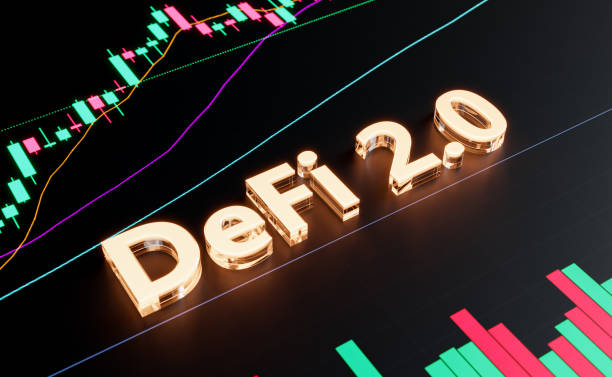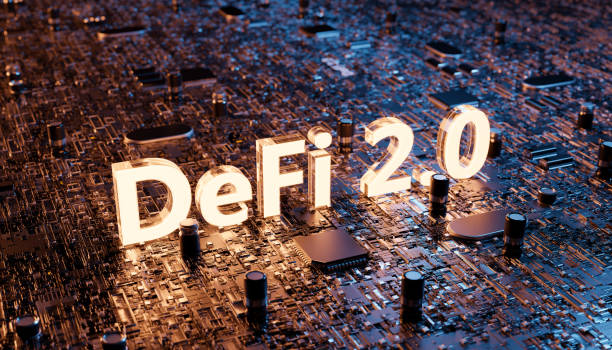DeFi 2.0 is a short description of the second generation of decentralized finance. Every tech-inclined innovation was mostly taking the world from its first phase to a new revolutionized era since there is some room for new models and many revolutionary concepts with the innovations.
Decentralized finance (DeFi) is not an exception. Since it is a blockchain-based innovation. The world seems to be ready to take on DeFi 2.0, which is the next generation of DeFi protocols that came up several years after decentralized finance was launched.
By description, DeFi is a wide spectrum of decentralized applications that are designed to disintermediate traditional financial services and then unlock an entirely new economic primitive. It is powered by blockchains that have built-in smart contract capabilities. These capabilities secure oracle networks like Chainlink.
As decentralized finance starts to approach new dawn or rebranded models and upgraded concepts, the DeFi 2.0 protocol is expected to come in handy.
Related:Will Decentralized Finance (DeFi) Take over the World?
DeFi 2.0 Is the Upgrade Of DeFi Protocols
DeFi 2.0 is the second generation of DeFi protocol technology. It is a new phrase used in the blockchain world to refer to a subset of DeFi protocols built on prior DeFi breakthroughs like lending and yield farming. Most of the on-chain systems that have native tokens experience a lot of liquidity limitations. That is a notable focus for the DeFi 2.0 implementations.
Decentralized finance is a system that shelters all the decentralized platforms and projects that are designed to introduce new blockchain-based financial models and economic primitives while disengaging the general traditional financial system.
The issuance of decentralized applications and projects depends on proven models of financial-based agreements. The protocols evolve since they consist of permissionless composability and open-source development trend that gives the sector customized benefits.
DeFi has so far earned lots of significance in the blockchain world in a few years of its existence and evolution. Decentralized finance adoption has been growing at a fast rate since the start of 2021 as a result of the efficiencies that it has introduced into the global financial system.
Thus, it is rapidly bringing in a new era of decentralized finance applications dubbed DeFi 2.0. Amid the many limitations that affect DeFi 1.0, the system started to see breakthroughs in the issues of liquidity limitations, yield farming, and much more. Thus, it is now serving as a frontrunner that has brought up lots of expectations geared towards the second class of DeFi.
Why Does DeFi 2.0 Matter?
The iteration of DeFi 2.0 brings in a new era of revolutionized decentralized finance protocols that seem to resolve the limitations with the early generation of DeFi. This second version of DeFi aims to incorporate new solutions and innovations. Hence, it is expected to bring progress for the space while offering consumers new and exciting mechanisms to push them constantly towards financial freedom.
Unfriendly user interface and scalability challenges have affected the operation of early DeFi protocols since most solutions are powered by the Ethereum blockchain. The model structure is quite complex, which makes it hard for the new users to use available decentralized products.
The massive gas fees and long waiting hours to execute transactions in the DeFi space have been challenging. These limitations have made many people lose interest in using DeFi platforms. Nevertheless, DeFi 2.0 is designed to unveil important networks that can resolve Ethereum’s scaling issues.
Related:Sheesha Finance Talks to Us about Decentralized Finance (DeFi)
Furthermore, most assets in the DeFi industry are underused and static in the case of liquidity. The poor liquidity solutions also result in a low utilization ratio among the potential users. Automated Market Maker (AMM) supports exclusive access to operating capital. But, this model is not effectively used as a result of the AMM design that prevents concentration of liquidity.
In the meantime, DeFi 2.0 ensures that the deposited assets are utilized to their full potential. Therefore, it is now making way for a smooth cash flow to effectively sustain and support a variety of projects. Other challenges that exist in the current decentralized finance that DeFi 2.0 seeks to resolve include intermediary information and oracles, security issues, centralizations, and many other issues.
Examples Of DeFi 2.0
Some of the new projects are building protocols using the decentralized finance 2.0 toolkits. Therefore, they appear to be preparing the nascent sector for the next phase of decentralized finance. Some examples of the projects and use cases include:
- Avalanche (AVAX) – A swift, low-cost programmable smart contract platform where dApps of DeFi 2.0 can be built.
- Olympus DAO (OHM) is a decentralized reserve currency model that has LP, bonds, staking, and a lot more.
- Convex (CVX) and Curve Finance (CRV) is a major TVL of DeFi protocols. Curve is the exchange, DAO, stablecoin, LP, and more, where the yield farming platform Convex is hosted.
- Yearn Finance (YFI) is a yield and lending aggregator and insurance provider that works on the Ethereum blockchain.
Advantages Of DeFi 2.0
This second generation of decentralized finance promises many functionalities aiming to make the space easy to deploy for the users. With DeFi 2.0 coming up, users are assured of insurance on particular smart contracts to reduce the risks that are linked with compromising smart contracts.
Moreover, DeFi 2.0 protects users against the risk of impermanent loss. Eventually, the second generation of decentralized finance also mitigates risks that are linked to lending processes and eliminates interest that is payable on the loans.
Decentralized finance also reduces the costs that come with executing transactions. Hence, the sector charges low gas fees and the transaction processes are swift. Furthermore, DeFi 2.0 promises a dependable liquidity supply. All the protocols that require liquidity can effectively have access to them.
Risks Of DeFi 2.0 And How To Prevent Them
Although the DeFi 2.0 protocol promises many advantages, it also comes with some risks. For starters, there is investment risk. Investing in financial instruments is quite risky. Therefore, the dApps that operate on DeFi 2.0 are not an exemption. As such, it may expose users to different investment risks as smart contracts in the new era might also have some unwanted loopholes.
Related:What Are The Major Decentralized Finance (DeFi) Ecosystem Problems?
Investors are thus advised to conduct extensive research on all projects that they wish to invest in. Secondly, there is looming liquidity risk. Risks that come with liquidation can be reduced but not eliminated.
Though DeFi 2.0 protects users from liquidity risks like impermanent losses, intending liquidity miners may be exposed to losing some funds. Thus, intending liquidity miners are better placed when they are competently and efficiently equipped.
Use Cases
Several projects are offering new DeFi services across many networks, including Binance Smart Chain, Ethereum, Solana, and many other smart contract capable blockchains. Here are some of the most notable use cases:
Unlocking Value Of Staked Funds
For anyone who has ever staked a token pair in a liquidity pool, they must have got LP tokens in return. DeFi 1.0 allowed users to stake the LP tokens with a yield farm to increase their profits. Before the introduction of DeFi 2.0, that was as far as the chain goes for extracting value.
Millions of dollars are currently locked in vaults offering liquidity. However, there is a possibility of enhancing capital efficiency. The new DeFi protocol pushes it further by using these yield farm LP tokens as collateral. It might be for a cryptocurrency loan from a lending protocol or mint tokens in a process that is similar to MakerDAO (DAI).
The specific mechanism changes by project. However, the idea is that your LP tokens must have their value unlocked for new opportunities while generating lots of APY.
Smart Contract Insurance
Reviewing and doing due diligence on smart contracts is challenging unless one is an experienced developer. Without the know-how, you can only manage to evaluate a project partially. It brings a lot of risks when investing in decentralized finance projects. On the other hand, with the introduction of DeFi 2.0, it is possible to get decentralized finance insurance on particular smart contracts.
When using a yield optimizer and having staked LP tokens in its smart contract, any compromise might result in the loss of all deposits. An insurance project assures deposits with the yield farm for a fee. But, that is just for a particular smart contract. Normally, you never get any payout in case the liquidity pool contract gets compromised. Nevertheless, in case the yield farm contract gets compromised but covered by the available insurance, you may get a payout.
Related: 5 Charts to Uncover Your Next Long Term DeFi Investment
Impermanent Loss Insurance
When you invest in start liquidity mining and a liquidity pool, changes in the price ratio of the two tokens you locked might result in financial losses. That process is called impermanent loss. Nonetheless, DeFi 2.0 protocols are exploring new ways of minimizing the risks.
For instance, when you add a token to a single-sided LP where you do not require a pair, the protocol adds their native token to work as the other side of the pair. You then get the fees paid from swaps in the particular pair, and so will the protocol.
After some time, the hosting protocol uses their fees to create an insurance fund to secure deposits invested against effects that come with impermanent loss. Whenever there are not enough fees to pay off losses, the protocol mints new tokens which cover them. In cases of excess tokens, they are stored for later use or get burned to reduce supply.
Self-Repaying Loans
Normally, taking loans involve liquidation risk and interest payments. However, it is not the case with DeFi 2.0. For instance, if you take a loan of $100 from a crypto lender, they give you $100 worth of crypto but need $50 as collateral.
After you give the deposit, lenders use it to earn interest to pay off your loan. Once the lender earns $100 with your crypto and more as a premium, your deposit is returned. In that case, there is no risk of liquidation there. Whenever the collateral token depreciates, it only takes longer for that loan to be paid off.
The Takeaway
As the tech space continues thriving, DeFi 2.0 is expected to fight risks associated with DeFi 1.0. Thus, the system of decentralized finance will become much better as people venture into the new space. In that context, the new phase sees DeFi becoming highly flexible to use, which is constantly pushing blockchain technology towards mainstream adoption.










